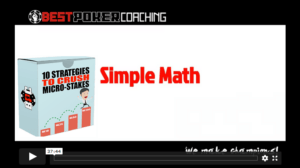In a normal 9-man SNG, the bubble is when the tournament is down to four players and often marked by increased aggression and all-in situations. It’s called the bubble because it will soon burst for one of the four remaining players since only three will finish in the money, typically. Of course, there are other payment structures but this is the most common. How you approach this stage of the tournament really depends on your stack size.
If stacks are small relative to the size of the blinds, the bubble is completed fairly quickly. Depending on how fast the first few players are eliminated and the rate at which the blinds increase, the average stack is likely going to be around 10-15 big blinds. As the bubble draws near, many players begin to tighten up so they can sneak into the money. This can be a strategic mistake, but how you play during this key stage of a sit and go is dependent on your stack size and that’s what we’ll look at in this lesson.
PLAYING THE BIG STACK ON THE BUBBLE
If you are fortunate to have the largest remaining chip stack, you are in a powerful position. You’re almost guaranteed to make the money, especially when the other stacks are small. At this point, you should take note of the other three players’ stack size and their relative position at the table. If the next largest chip stack is on your right, you have a major advantage because you act after them. Since you have the second largest stack covered, most players in this spot will be afraid of busting out and will look to avoid confrontations with you without a very strong hand.
You can and should attack the two short stacks at the table with all-in bets, only backing off when their stacks get to be around 3.5 big blinds since they will be pot committed and will generally call you with any two cards. So at this point, you’ll want to have a slightly stronger range of hands when you know they are going to call.
When you’re the big stack in the big blind, you should respect raises from the second stack. However, be prepared to re-raise if you sense weakness since he will generally fold all but his strongest hands. If one of the short stacks goes all-in, you should be calling here with almost any two cards if their bet was for 3 big blinds or less. Your main goal as the big stack on the bubble is to eliminate the other players and get to the in-the-money stage as the chip leader.
PLAYING THE SECOND STACK ON THE BUBBLE
In typical SNG tournaments, you will find that the big stack gets very aggressive on the bubble, and it’s usually wise to let them have their way. You can get very aggressive when in the money and try to steal that advantage from them. But if the big stack is aggressive, let him knock out the short stacks cruise into the money yourself. If you are to the left of the big stack, you should take advantage of the times they fold. This will leave you with the remaining big stack left to act and where you can raise with a wide range of hands as long as the short stacks have at least 3 big blinds. Your main goal as the second largest stack on the bubble is to avoid confrontations with the big stack and cruise through the bubble and into the money.
PLAYING THE SHORT STACK ON THE BUBBLE
Playing the short stack on the bubble is a tough situation. If you are very short along with a second short stack, then you can be more conservative, hoping for an opportunity to raise all-in against the other short stack and/or hope the other short stack gets eliminated by another player first. If you are the only short stack, then forget about survival. The odds are up against you finishing in the money without some luck. Whatever you do, don’t let your stack get below 5 big blinds on the bubble. Pick a spot and move all-in and hope to either pick up the blinds or double up you chip stack. This your main goal as the short stack on the bubble.
At this point in the series, you should have learned the basic strategy of playing SNGs from the first hand up until the bubble. If you have questions, go back and review the specific sections you’re unsure of. The next lesson will focus on how to play 3-handed when in the money.
WANT TO REVIEW PREVIOUS LESSONS?
If you’re just jumping into this 60-Minute Master series for SNGs or would like to review what you’ve learned so far, here are the links to all previous lessons. If you have questions or comments, please feel free to do so in the comments section below.



